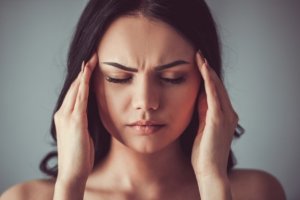Four Types of Headaches and Their Treatments

In this article, we’ll talk about four types of headaches and their respective treatments. Treating each of these types of headaches depends on their particular characteristics as well as your habits.
Therefore, knowing the differences between the types of headaches will help you understand what we mean by “strong headaches” and how best to treat each one. Keep reading so you can find out more.
1. Types of Headaches: Migraines

Migraines are the first of the types of headaches that we’ll talk about. Generally, people who suffer them feel like they can’t do anything. That’s why they’re quite difficult to deal with.
Believe it or not, migraines are hereditary. That means that if you suffer from them, it’s very likely that someone else in your family also does.
This is the most widespread headache followed by tension headaches. It has the following characteristics:
- The pain appears in one part of your head and can last up to three days.
- Pain usually appears as a throb. Then, it increases when you move in certain ways. For example, it might increase when you bend over or get up after sitting.
- Extreme sensitivity to light or noise. Therefore, resting in the dark and in silence will help you feel better.
- You may even feel nauseous if you don’t treat it.
Migraines may happen due to menstruation, stressful situations, certain foods, taking certain drugs or medications, or weather changes.
Migraines don’t have a cure. However, with the right treatment, physical exercise, and stress management techniques, you can reduce their frequency.
2. Tension Headaches
The second type is also known as “primary” headaches. Contrary to migraines, the pain from tension headaches usually appears in the occipital region of your head, cervical region, or your forehead. Generally, it’s not very intense, and you won’t experience nausea or vomiting.
This isn’t as debilitating as migraines. Generally, people with these types of headaches can go on with their day normally. In fact, sometimes people can even exercise. However, they are much more frequent, and they can last between one and seven days.
Usually, taking too many drugs without a prescription can cause tension headaches. However, stress, caffeine withdrawal, and grinding your teeth can also cause them. In many cases, ibuprofen helps reduce the pain a lot.
You might like: What You Need to Know About Ibuprofen
3. Chronic Headaches

Like the previous headache, this is one of the types of headaches that are normally caused by taking too many drugs without a prescription. The only difference with respect to the previous headache is that it’s present almost every day. In fact, people that suffer from chronic headaches usually suffer for an average of 15 days month.
To prevent these, we recommend not taking too many medications or, at the very minimum, talking with your doctor to evaluate which of the medications you’re taking is really necessary.
Discover: The FDA Approves a New Medication to Prevent Migraines
4. The Types of Headaches: Cluster Headaches
The last of our types of headaches is cluster headaches. Although they have some of the same symptoms as migraines, they have some different symptoms as well:
- Unbearable pain. Often, it’s located around your eye and on the side of your head.
- Clogged nose, and occasionally a runny nose on the side of your head that hurts.
- Eyelid drooping and swelling around the affected eye.
- Pale skin or redness.
Cluster headaches usually last only a few minutes, but you may have several episodes in the same day. Normally, these headaches appear at night and at the same times. Often, outbreaks of cluster headaches can last for several weeks.
Like the previous types of headaches, you might want to consider treatments to try and keep these outbreaks under control. However, you might be able to treat them with just ibuprofen or paracetamol.
Do you have any symptoms of the headaches we talked about? Have you ever been diagnosed with migraines or any of the other types of headaches?
Now that you know about different types of headaches, you can identify them better. Don’t forget: you should only follow treatments that your doctor prescribes you.
All cited sources were thoroughly reviewed by our team to ensure their quality, reliability, currency, and validity. The bibliography of this article was considered reliable and of academic or scientific accuracy.
- Higes Pascual, F., Cubilla Salinas, M. A., & Yusta Izquierdo, A. (2015). Cefalea (III): cefalea en racimos, secundarias, farmacológicas y respondedoras a indometacina. Medicine (Spain), 11(70), 4167–4183. https://doi.org/10.1016/S0304-5412(15)70895-4
- Orgaz, A. C. (2011). Cefalea en racimos. Medicine, 10(70), 4759–4769. https://doi.org/10.1016/S0304-5412(11)70005-1
- Volcy-Gómez M. Cefalea crónica diaria: II. Tratamiento. Rev Neurol 2005;40 (03):180-187 https://www.neurologia.com/articulo/2004387
- Yusta Izquierdo, A., Cubilla Salinas, M. A., Sánchez Palomo, M. J., & Higes Pascual, F. (2015). Cefalea (II). Migraña. Medicine (Spain). https://doi.org/10.1016/S0304-5412(15)70894-2
This text is provided for informational purposes only and does not replace consultation with a professional. If in doubt, consult your specialist.








